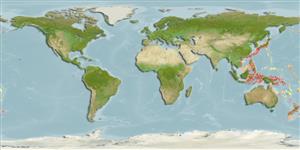Environment: milieu / climate zone / Tiefenbereich / distribution range
Ökologie
seewasser bathydemersal; tiefenbereich 250 - 300 m (Ref. 28016). Deep-water
Western Pacific: southern Japan to the South China Sea except Ryukyu Islands.
Size / Gewicht / Alter
Geschlechtsreife: Lm ? range ? - ? cm
Max length : 18.0 cm TL Männchen/unbestimmt; (Ref. 2272)
Rückenflossenstacheln (insgesamt) : 4 - 6; Rückenflossenweichstrahlen (insgesamt) : 13 - 15; Afterflossenweichstrahlen: 13 - 15; Wirbelzahl: 26. Lower edge of preopercle with 3 spines, very rarely to be more. Labial fimbriae simple and poorly developed. Posterior nostril slitlike. Dorsoposterior margin of pectoral fin slightly concave; pectoral and caudal fins pale yellow in fresh specimens. Fifth proximal anal pterygiophore (the first to follow a complete haemal spine) usually inserts between the haemal spines of 13th and 14th vertebrae (Ref. 11439).
Body shape (shape guide): elongated.
Found near shore, down to 260 m, on sand and sandy mud bottoms (Ref. 11230). Spend a large part of their time buried in the mud or sand with only their eyes and a portion of the mouth protruding (Ref. 4716). Cleithral spine with venom gland (Ref. 57406).
Life cycle and mating behavior
Geschlechtsreife | Fortpflanzung | Ablaichen | Eier | Fecundity | Larven
Masuda, H., K. Amaoka, C. Araga, T. Uyeno and T. Yoshino, 1984. The fishes of the Japanese Archipelago. Vol. 1. Tokai University Press, Tokyo, Japan. 437 p. (text). (Ref. 559)
IUCN Rote Liste Status (Ref. 130435: Version 2025-1)
Nutzung durch Menschen
Fischereien: kommerziell; Aquarium: Kommerziell
Tools
Zusatzinformationen
Download XML
Internet Quellen
Estimates based on models
Preferred temperature (Ref.
123201): 1.8 - 14.9, mean 12.4 °C (based on 26 cells).
Phylogenetic diversity index (Ref.
82804): PD
50 = 0.5000 [Uniqueness, from 0.5 = low to 2.0 = high].
Bayesian length-weight: a=0.00794 (0.00322 - 0.01959), b=3.09 (2.89 - 3.29), in cm total length, based on LWR estimates for this Genus-body shape (Ref.
93245).
Trophic level (Ref.
69278): 3.9 ±0.7 se; based on size and trophs of closest relatives
Widerstandsfähigkeit (Ref.
120179): mittel, Verdopplung der Population dauert 1,4 - 4,4 Jahre. (Assuming tmax>3).
Fishing Vulnerability (Ref.
59153): Low vulnerability (10 of 100).
🛈
